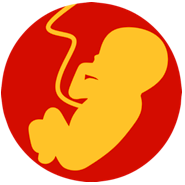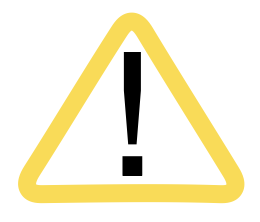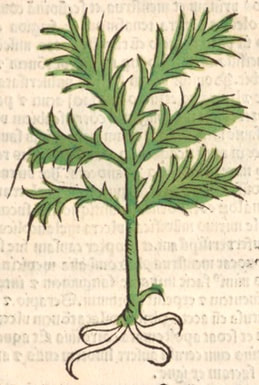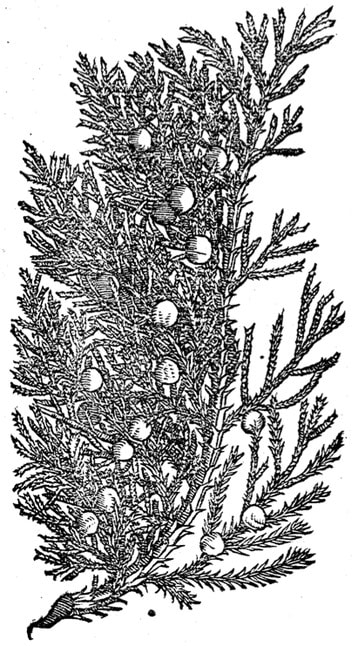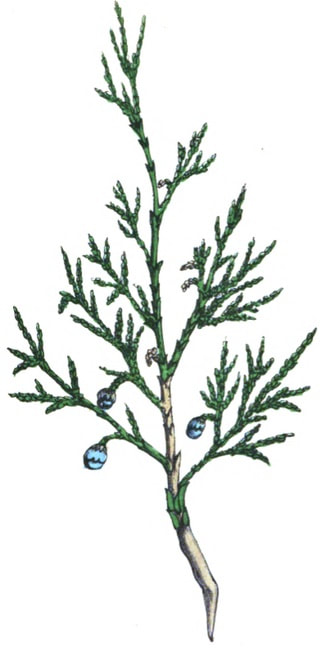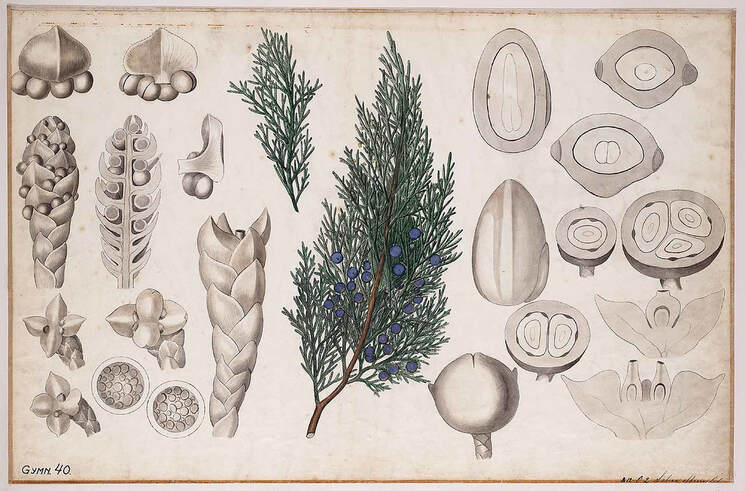Sentry Page Protection
Herbarius latinus, Petri, 1485
|
Dioscorides Materia Medica, Mathias, 1563
|
The Family Flora and Materia Medica Botanica, Good, 1847
|
Botanische wandplaten, 1904–1914
Botanical name:
Juniperus sabina
Parts used:
Leaf; sometimes the Fruit (Fruit is used in Persian Medicine)
Temperature & Taste:
Very Warm, dry. Pungent, Bitter.
of thin parts, cuts, attenuates, discusses
Classifications:
2B ATTENUATER. 2F. PURIFYING. 2K. RESOLVENT
3G. EMMENAGOGUE. 3M. ARTHRITICS.
4i. UTERINE
Juniperus sabina
Parts used:
Leaf; sometimes the Fruit (Fruit is used in Persian Medicine)
Temperature & Taste:
Very Warm, dry. Pungent, Bitter.
of thin parts, cuts, attenuates, discusses
Classifications:
2B ATTENUATER. 2F. PURIFYING. 2K. RESOLVENT
3G. EMMENAGOGUE. 3M. ARTHRITICS.
4i. UTERINE
Uses:
1. Moves the Blood, Strongly Promotes Menstruation, Eases Pain:
-primarily used for amenorrhea, dysmenorrhea and uterus obstruction
-to clear a Dead Fetus and induce Abortion; even the smoke of the burning leaves does the same (Dioscorides)
-externally for diseases of the Uterus
-small doses have been used for profuse menstruation (Fernie, 1897)
-it has been used for other types of pain from blood stagnation
-"Sabina tincture, 10 drop doses in water, is a safe and certain remedy for Amenorrhoea, and in 5 drop doses, equally good for Menorrhagia; the same is excellent for Chronic Gout and Rheumatic stiffness of the joints." (The medical genius, Jones, 1887)
2. Clears Wind-Damp, promotes Urine:
-urinary disorders with cold and damp obstruction
-Ancients praised it highly for Jaundice (Apuleius)
-Wind-Cold-Damp type Arthritis, Sciatica, Hip pain
3. Clears Wind-Cold:
-closely related Chinese species is used for Cold and Flu
-the western variety has been used for Cough and Asthma
4. Kills Worms
-oil applied to the abdomen of children
5. Externally:
-to remove Freckles and spots of the Face and skin (Dioscorides)
-'Creeping [cancerous] ulcers'
-the fresh leaves beaten to a paste are applied to running or fretting Cancers to ‘kill and destroy them’. (Pemell, Tractus de Facultatibus simplicium, 1653)
-applied topically to Warts and Corns (volatile oil)
-topically with Honey to clear skin Spots, Freckles, and for Sunburn.
-the Distilled Water is applied to Spots and Marks of the skin.
-applied to Boils and Carbuncles
-the crushed herb or strong decoction is applied to skin infections.
-beaten with Hogs lard to form a catapalsm, it is applied to Scabby Heads of children.
-to dry up sore the Heads of children (applied with Cream)
-applied to teh pubis for Strangury or Dysuria (Herbarius latinus, Petri, 1485)
Dose:
Infusion: 1–2 grams per cup of boiling water
Powder: 300mg–1 gram per dose, maximum 2 grams per day
Oil: 0.05 gram, maximum 0.5 gram per day
Note:
It has been called ‘The most certain and powerful Emmenagogue of the whole Materia Medica’. (Pereira)
Substitute:
1. 'said to have the same effect as cinnamon, if taken in doses twice as large'. (Pliny)
Infusion: 1–2 grams per cup of boiling water
Powder: 300mg–1 gram per dose, maximum 2 grams per day
Oil: 0.05 gram, maximum 0.5 gram per day
Note:
It has been called ‘The most certain and powerful Emmenagogue of the whole Materia Medica’. (Pereira)
Substitute:
1. 'said to have the same effect as cinnamon, if taken in doses twice as large'. (Pliny)
Main Combinations:
Gynecology
1. To promote Menstruation:
i. Savin with Dittany of Crete, Myrrh and Gum Ammoniac
ii. Savin with Mugwort and Saffron
iii. Savin with Mugwort, Marjoram, Balm
iv. Savin with Myrrh, Cinnamon, Celery seed, Parsley seed, Spikenard (as in Powder to Promote Menstruation)
v. Savin with Cyperus, Angelica, Valerian, Madder, Mugwort, Pennyroyal, Carrot seed, Cinnamon, Saffron (as in Emmenagogue Decoction)
vi. Savin with Cinnamon, Myrrh, Celery seed, Parsley seed, Spikenard, Asarum, Rhubarb, Saffron, Madder, Rue, Pennyroyal, Mugwort (as in Tincture for Suppressed Menstruation)
vii. Savin with Mugwort, Orange flower, Rue (Emmenagogue Potion, from Formulaire Magistral et Memorial Pharmaceutique, 1823)
viii. Savin juice clarified (2 oz.), Cinamon (2 drams), Saffron (4 grains), Distilled Water of Radish root (2 oz.). Divide into 2 doses. (The Secrets of Alexis, 1615)
2. Amenorrhea with weakness and atony of the Uterus, Savin with Valerian, Cinnamon, Saffron (Sobernheim, 1840)
3. Powerfully promote Menstruation
i. Savin with Ginger and Borax
ii. Savin, Ginger (1 dram each), Potassium sulphate (2 drams). Make 6 doses.
iii. Savin, Camomile extract (1 ½ drams each), Iron oxide, Aloes (15 grains each). Make pills of 2 grains. Dose: 6 pills
iv. Savin with Borax, Myrrh, Birthwort and Pennyroyal
Obstetrics
4. To promote Labor
i. Savin with Cinnamon, Saffron
ii. Savin with Marjoram, Indian Spikenard, Lavender (as in Decoction for Difficult Childbirth)
iii. Savin with Pennyroyal, Mugwort, Cassia Fistula, Saffron, Cinnamon, Myrrh (as in Powder to Facilitate Birth)
5. To cleanse the Afterbirth, Savin with Cinnamon
Joint Disease
6. Hip or lower back pain, Sciatica, Savin with Germander, Myrrh, Black Pepper, Ivy leaf, Honey (Nicholas)
7. Arthritis: Savin (1 dram), Calamus (2 drams), Honey (2 oz.) (Anti-Arthritic Electuary, Pharmacopoeia Pauperum Hamburgensis, 1804)
Other
8. Pain due to blood stagnation, Savin with St. Johns wort, Feverfew, Peony, Rue and Costus
9. Tremors, Shaking, Savin with Black Myrobalan, Cyperus, Calamus (as in Expert Confection for Tremors)
10. To promote Urine:
i. Savin with Celery seed, Madder, Parsley seed, Asarum, Indian Spikenard, Bitter Almond, Melon seed (as in Pills to Promote Urine)
Externally
11. Fomentation for Worms, Savin with Wormwood, Lavender, Tansy, applied to the abdomen
12. Condylomata, topically Savin with Copper sulphate, equal parts
13. Freckles and spots of the face, leaves are applied with Honey (Dioscorides)
14. Strangury, Dysuria, Savin with Dill seed and Mallow herb boiled in wine and applied. (Herbarius latinus, Petri, 1485)
Major Formulas:
Decoction for Difficult Childbirth (Barbette)
Decoction for the Womb (Schroder)
Emmenagogue Decoction (Riverius)
Syrup of Mugwort Lesser (Bononiense)
Syrup of Mugwort (Augustana)
Powder for Warts
Powder to Facilitate Birth (Renodeus)
Powder to Cleanse the Afterbirth
Powder of Gum Lacca Lesser of Rhasis (Dialacca Minor) (Rhasis)
Powder of Gum Lacca Greater (Dialacca Majores) (Mesue)
Powder of Madder (Salmon)
Troches for the Womb
Expert Confection for Tremors
Antidote Proven for Hip Pain (Nicholas)
Cautions:
1. Not used during pregnancy.
2. Toxic in overdose. Toxic effects appear 10 hours to several days after a toxic dose.
3. Not used in cases with Heat or Yin deficiency.
Main Preparations used:
Distilled Water of the Leaves, Distilled Oil
1. Not used during pregnancy.
2. Toxic in overdose. Toxic effects appear 10 hours to several days after a toxic dose.
3. Not used in cases with Heat or Yin deficiency.
Main Preparations used:
Distilled Water of the Leaves, Distilled Oil
Click the Tabs above for more information on this Medicine
Pliny on Savin:
|
'Of the herb savin, known as "brathy" by the Greeks, there are two varieties, one of them with a leaf like that of the tamarix, the other with that of the cypress; for which reason some persons have called this last the Cretan Cypress. It is used by many for fumigations, as a substitute for frankincense; employed in medicine, it is said to have the same effect as cinnamon, if taken in doses twice as large. It reduces gatherings, disperses corrosive sores, acts as
|
a detergent upon ulcers, and, used as a pessary and as a fumigation, brings away the dead foetus. It is employed as a topical application for erysipelas and carbuncles, and, taken with honey in wine, is curative of jaundice.
The smoke of this plant, they say, cures the pip in all kinds of poultry.' (The Natural History of Pliny, trans. by Bostock and Riley, Vol. 5, 1856) |
1. GENERAL / REVIEW:
–Essential Oil Composition and Bioactivity of Two Juniper Species from Bulgaria and Slovakia
2. ANALGESIC:
–Evaluation on Analgesic and Anti-Inflammatory Activities of Total Flavonoids from Juniperus sabina
3. ANTI-INFLAMMATORY
–Evaluation on Analgesic and Anti-Inflammatory Activities of Total Flavonoids from Juniperus sabina
4. IMMUNO-MODULATORY:
–Innate Immunomodulatory Activity of Cedrol, a Component of Essential Oils Isolated from Juniperus Species
5. ANTI-CHOLINESTERASE
–Effects of medicinal plants on Alzheimer's disease and memory deficits
6. ANTI-COAGULANT:
–Comparative Analysis of Chemical Profile, Antioxidant, In-vitro and In-vivo Antidiabetic Activities of Juniperus foetidissima Willd. and Juniperus sabina L.
7. HEPATOPROTECTIVE:
–Characterization and hepatoprotective evaluation of sesquiterpenes and diterpenes from the aerial parts of Juniperus sabina L.
–Chemical composition and protective effect of Juniperus sabina L. essential oil against CCl4 induced hepatotoxicity
8. DIABETES:
–Middle East Medicinal Plants in the Treatment of Diabetes: A Review
–Comparative Analysis of Chemical Profile, Antioxidant, In-vitro and In-vivo Antidiabetic Activities of Juniperus foetidissima Willd. and Juniperus sabina L.
9. ARTHRITIS:
–Anti-arthritic Effects of Total Flavonoids from Juniperus sabina on Complete Freund's Adjuvant Induced Arthritis in Rats
10. ANTI-FERTILITY:
–Podophyllotoxin Extracted from Juniperus sabina Fruit Inhibits Rat Sperm Maturation and Fertility by Promoting Epididymal Epithelial Cell Apoptosis
11. CANCER:
–Junipers of Various Origins as Potential Sources of the Anticancer Drug Precursor Podophyllotoxin
–Comparison of the cytotoxic effects of Juniperus sabina and Zataria multiflora extracts with Taxus baccata extract and Cisplatin on normal and cancer cell lines
–Essential Oil Composition and Bioactivity of Two Juniper Species from Bulgaria and Slovakia
2. ANALGESIC:
–Evaluation on Analgesic and Anti-Inflammatory Activities of Total Flavonoids from Juniperus sabina
3. ANTI-INFLAMMATORY
–Evaluation on Analgesic and Anti-Inflammatory Activities of Total Flavonoids from Juniperus sabina
4. IMMUNO-MODULATORY:
–Innate Immunomodulatory Activity of Cedrol, a Component of Essential Oils Isolated from Juniperus Species
5. ANTI-CHOLINESTERASE
–Effects of medicinal plants on Alzheimer's disease and memory deficits
6. ANTI-COAGULANT:
–Comparative Analysis of Chemical Profile, Antioxidant, In-vitro and In-vivo Antidiabetic Activities of Juniperus foetidissima Willd. and Juniperus sabina L.
7. HEPATOPROTECTIVE:
–Characterization and hepatoprotective evaluation of sesquiterpenes and diterpenes from the aerial parts of Juniperus sabina L.
–Chemical composition and protective effect of Juniperus sabina L. essential oil against CCl4 induced hepatotoxicity
8. DIABETES:
–Middle East Medicinal Plants in the Treatment of Diabetes: A Review
–Comparative Analysis of Chemical Profile, Antioxidant, In-vitro and In-vivo Antidiabetic Activities of Juniperus foetidissima Willd. and Juniperus sabina L.
9. ARTHRITIS:
–Anti-arthritic Effects of Total Flavonoids from Juniperus sabina on Complete Freund's Adjuvant Induced Arthritis in Rats
10. ANTI-FERTILITY:
–Podophyllotoxin Extracted from Juniperus sabina Fruit Inhibits Rat Sperm Maturation and Fertility by Promoting Epididymal Epithelial Cell Apoptosis
11. CANCER:
–Junipers of Various Origins as Potential Sources of the Anticancer Drug Precursor Podophyllotoxin
–Comparison of the cytotoxic effects of Juniperus sabina and Zataria multiflora extracts with Taxus baccata extract and Cisplatin on normal and cancer cell lines

